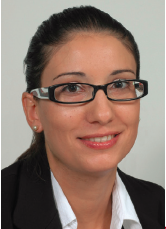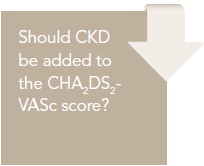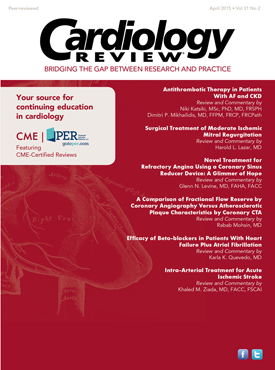Publication
Article
Cardiology Review® Online
Antithrombotic Therapy in Patients with Atrial Fibrillation and Chronic Kidney Disease
The presence of chronic kidney disease (CKD) in patients with atrial fibrillation increases the risk of stroke and thromboembolism (TE) as well as the risk of bleeding, thus complicating their treatment. In this context, it has been suggested that CKD should be included in the CHA2DS2-VASc (Congestive heart failure; Hypertension; Age ≥75 years; Diabetes mellitus; previous Stroke, transient ischemic attack, or thromboembolism; Vascular disease; Age 65 to 74 years; Sex category) score.

Niki Katsiki, MSc, PhD, MD, FRSPH
Review
Bonde AN, Lip GY, Kamper AL, et al. Net clinical benefit of antithrombotic therapy in patients with atrial fibrillation and chronic kidney disease: a nationwide observational cohort study. J Am Coll Cardiol. 2014;64(23):2471-2482.

The presence of chronic kidney disease (CKD) in patients with atrial fibrillation (AF) increases the risk of stroke and thromboembolism (TE) as well as the risk of bleeding, thus complicating their treatment. In this context, it has been suggested that CKD should be included in the CHA2DS2-VASc (Congestive heart failure; Hypertension; Age ≥75 years; Diabetes mellitus; previous Stroke, transient ischemic attack, or thromboembolism; Vascular disease; Age 65 to 74 years; Sex category) score. In the present study, Bonde et al1 evaluated the net clinical benefit of warfarin therapy as assessed by composite end points of death/hospitalization from stroke/bleeding, cardiovascular death, and all-cause mortality in nonvalvular AF patients with CKD (both non—end-stage and end-stage treated with renal replacement therapy).
Study Details
Bonde et al1 assessed all patients discharged from a Danish hospital with the diagnosis of nonvalvular AF from January 1, 1997, through December 31, 2011. After exclusions, 11,128 had non—end stage CKD (4519 of them at inclusion) and 1728 patients were on renal replacement therapy (RRT) (1142 of them at inclusion).1 The risks of stroke/TE and bleeding were assessed using the CHA2DS2-VASc and the HAS-BLED (Hypertension, Abnormal renal function, abnormal liver function, Stroke, Bleeding, Labile international normalized ratio, Elderly, Drug therapy, alcohol intake) scores. Study outcomes were death/hospitalization from stroke/TE (to determine CKD-related risk for stroke/TE), all-cause mortality, and a composite of death/hospitalization from stroke/TE/bleeding (these 2 outcomes defined the net clinical benefit of antithrombotic therapy), cardiovascular mortality, and a composite of fatal stroke/fatal bleeding.1
The median follow-up for non-CKD, non—end-stage CKD, and RRT patients was 1179, 312, and 603 days, respectively; the corresponding rates of stroke/TE were 13.4%, 9.9%, and 13.2%.1
In patients not receiving warfarin, the stroke/TE rate per 100 person-years increased in non—end-stage CKD and RRT patients compared with non-CKD patients, both in patients with CHA2DS2-VASc score = 0 (2.1, 4.2, and 0.8, respectively) and in those with CHA2DS2-VASc score ≥2 (7.2, 7.3, and 5.3, respectively).1 In patients treated with warfarin, stroke/TE rates were also higher in non—end-stage CKD and RRT patients compared with non-CKD patients in patients with CHA2DS2-VASc score = 1 (1.8, 3.3, and 1.0, respectively) and in those with CHA2DS2-VASc score ≥2 (5.8, 4.8, and 2.9, respectively). Overall, stroke/TE rates were lower in patients receiving warfarin than patients not on warfarin except for non—end-stage CKD and RRT patients with CHA2DS2-VASc score = 1.
In Cox regression models, adjusted for CHA2DS2-VASc score and aspirin treatment or all baseline medication, CKD was independently associated with a higher risk for stroke/TE both in patients with non—end-stage CKD and RRT compared with non-CKD patients, except for non–end-stage CKD with CHA2DS2-VASc score = 1. In high-risk patients (CHA2DS2-VASc score ≥2), the risk for stroke/TE was 1.3-fold higher in patients with non—end-stage CKD and 1.6-fold higher in patients with RRT.1 The risk was significantly higher in RRT patients compared with non—end-stage CKD patients in those with CHA2DS2-VASc score ≥1.
With regard to the net clinical benefit of antithrombotic therapy, in non—end-stage CKD patients, warfarin was associated with a significantly lower risk of all-cause mortality in both high-risk and low-/intermediate-risk patients, as well as a significantly decreased risk of cardiovascular mortality in high-risk patients.1 Furthermore, the risk of fatal stroke/fatal bleeding was significantly lower in warfarin-treated high-risk non—end-stage CKD patients. Aspirin and aspirin plus warfarin treatments were related only to a decreased risk of all-cause mortality. In high-risk RRT patients, the risk of all-cause mortality was significantly lower in patients on warfarin. In contrast, aspirin or aspirin-plus-warfarin therapy was not associated with a lower risk of any outcome in RRT patients.1
Commentary
Future studies are needed to establish whether CKD should be added to the CHA2DS2-VASc score
In the present study,1 Bonde et al found that patients on RRT had a significantly higher risk of stroke/TE in all strata of the CHA2DS2-VASc score (from 5.5- to 1.6-fold higher risk in low-risk and high-risk patients, respectively). Non—end-stage CKD was independently related with a greater risk of stroke/TE in patients with CHA2DS2-VASc = 0 or ≥ 2. These findings support the addition of CKD to the CHA2DS2-VASc score, thus helping to identify those patients at an increased risk. Of note, CKD has been associated with platelet dysfunction and abnormalities in the coagulation cascade and the microvasculature, thus predisposing to hemostatic disorders.2 Microparticles and microRNAs may also be implicated in the pathophysiology of impaired coagulation in CKD.3 Furthermore, in the present study1 warfarin was shown to exert a significant net clinical benefit in both low/intermediate- and high-risk patients with non—end-stage CKD as well as in high-risk patients (with CHA2DS2-VASc score ≥2) on RRT.1
In the Bonde et al study1, international normalized ratio (INR) data were not available and therefore the quality of the antithrombotic treatment cannot be defined. Time in therapeutic range (TTR) during warfarin therapy is of major importance for both the efficacy and safety of this treatment. In this context, TTR was inversely correlated with the rate of stroke/systemic embolism in patients with nonvalvular AF4; TTR has also been associated with bleeding and mortality.5 Home monitoring of INR may result in better rates of TTR and reduced strokes and deaths6,7 and thus it should be implemented in patients that are adequately trained and capable of self-management.6 Furthermore, the cost-effectiveness of this home-based point-of-care monitoring compared with hospital-based services was recently reported.7 Of note, the majority of patients in the present study1 were ≥ 65 years old, and thus more prone not only to thromboembolic but also to warfarin-related hemorrhagic events; for this reason, oral anticoagulation drugs are often underused in this population.8,9 Monitoring warfarin therapy may also present more difficulties in the elderly, further reducing the quality of antithrombotic treatment.
In the Bonde et al study1 concomitant drug therapy was assessed only by prescriptions, which may not reflect patient adherence to treatment. This is a limitation of the present study. Furthermore, apart from warfarin, other anticoagulants were not evaluated. Non-vitamin K oral anticoagulants (NOACs) have been introduced in the treatment of AF and venous TE with a better safety profile and at least equivalent (or superior in some cases) effectiveness than other anticoagulants.10
Furthermore, therapy with NOACs does not require routine monitoring due to their wide therapeutic window, although there are some suggestions with regard to available laboratory tests and reversal strategies.11 However, dose adjustment is required for some NOACs in the presence of renal impairment.12 Warfarin treatment has been associated with several food and drug interactions, and this should be taken into consideration in the interpretation of the results of clinical trials. NOACs have fewer interactions than the amount observed with warfarin.13
As Bonde et al1 mention in their discussion of the limitations of their study, glomerular filtration rate was not available for all patients, and thus the non—end-stage CKD group could not be stratified into categories according to kidney function. Measurement and long-term monitoring of renal function, as well as the required dose adjustments in warfarin dose based on frequent INR values, may increase the cost of treatment in AF patients on warfarin if CKD is included in the CHA2DS2-VASc score. Therefore, analyses of cost-effectiveness should be performed to evaluate the pros and cons of such an approach and also to evaluate comparisons with the use of NOACs in such patients.
In conclusion, Bonde et al1 reported that CKD was associated with a higher risk of stroke/TE in AF patients and that warfarin had a significant net clinical benefit in high-risk patients (with CHA2DS2-VASc score ≥2) on RRT as well as in both low/intermediate- and high-risk patients with non—end-stage CKD. Whether CKD should be added to the CHA2DS2-VASc score remains to be established in future studies.
References
1. Bonde AN, Lip GY, Kamper AL, et al. Net clinical benefit of antithrombotic therapy in patients with atrial fibrillation and chronic kidney disease: a nationwide observational cohort study. J Am Coll Cardiol. 2014;64:2471-2482.
2. Capodanno D, Angiolillo DJ. Antithrombotic therapy in patients with chronic kidney disease. Circulation. 2012;125:2649-2661.
3. Lutz J, Menke J, Sollinger D, Schinzel H, Thürmel K. Haemostasis in chronic kidney disease. Nephrol Dial Transplant. 2014;2:29-40.
4. Amin A, Deitelzweig S, Jing Y, et al. Estimation of the impact of warfarin's time-in-therapeutic range on stroke and major bleeding rates and its influence on the medical cost avoidance associated with novel oral anticoagulant use: learnings from ARISTOTLE, ROCKET-AF, and RE-LY trials. J Thromb Thrombolysis. 2014;38:150-159.
5. Hylek EM. Vitamin K antagonists and time in the therapeutic range: implications, challenges, and strategies for improvement. J Thromb Thrombolysis. 2013;35:333-335.
6. Ansell J. Point-of-care patient self-monitoring of oral vitamin K antagonist therapy. J Thromb Thrombolysis. 2013;35:339-341.
7. Craig JA, Chaplin S, Jenks M. Warfarin monitoring economic evaluation of point of care self-monitoring compared to clinic settings. J Med Econ. 2014;17:184-190.
8. Lip GY, Lane DA. Stroke prevention with oral anticoagulation therapy in patients with atrial fibrillation—focus on the elderly. Circ J. 2013;77:1380-1388.
9. Forman DE, Goyette RE. Oral anticoagulation therapy for elderly patients with atrial fibrillation: utility of bleeding risk covariates to better understand and moderate risks. Clin Appl Thromb Hemost. 2014;20:5-15.
10. Verheugt FW, Granger CB. Oral anticoagulants for stroke prevention in atrial fibrillation: current status, special situations, and unmet needs [published online March 11, 2015]. Lancet.
11. Silvain J, Hauguel M, Kerneis M, Collet JP, Montalescot G; ACTION Study Group. Measuring and Reversing the Effect of Non-Vitamin K Antagonist Oral Anticoagulants (NOACs). Circ J. 2015;79:289-291.
12. Cheng JW, Barillari G. Non-vitamin K antagonist oral anticoagulants in cardiovascular disease management: evidence and unanswered questions. J Clin Pharm Ther. 2014;39:118-135.
13. Saraf K, Morris P, Garg P, Sheridan P, Storey R. Non-vitamin K antagonist oral anticoagulants (NOACs): clinical evidence and therapeutic considerations. Postgrad Med J. 2014;90:520-528.
About the Authors
Niki Katsiki, MSC, PhD, MD, FRSPH, is a specialist in internal medicine and a researcher at the Medical School, Aristotle University of Thessaloniki, Thessaloniki, Greece. Her PhD was based on obesity-related peptides in diabetic patients. Dr Katsiki’s clinical and research interests involve cardiovascular disease prevention and treatment. She has participated in obesity, lipid, diabetes, peripheral artery disease, and smoking cessation outpatient clinics with a special focus on dyslipidemias. Dr Katsiki was an honorary clinical research fellow at the Department of Clinical Biochemistry, Royal Free Hospital campus, University College London Medical School, University College London (UCL), UK. She is also a SCOPE member, and a member of the International Association for the Study of Obesity. Dr Katsiki serves as a reviewer for several journals and as associate editor of Angiology (IF 2.37) and Archives of Medical Science (IF 1.89), as well as book review editor and news and views editor of Current Vascular Pharmacology (IF 2.908). Dr Katsiki has 155 publications listed in PubMed and more than 670 citations on the ISI, Core Collection.
She was assisted in the writing of this article by Dimitri P. Mikhailidis, BSc, MSc, MD, FRSPH, FCP, FFPM, FRCP, FRCPath, academic head of the Department of Clinical Biochemistry (Vascular Disease Prevention Clinics), and Department of Surgery, Royal Free Campus, University College London Medical School, UCL, London, UK. He is editor in chief of several journals, including Current Medical Research and Opinion, Current Vascular Pharmacology, and Expert Opinion on Pharmacotherapy.





